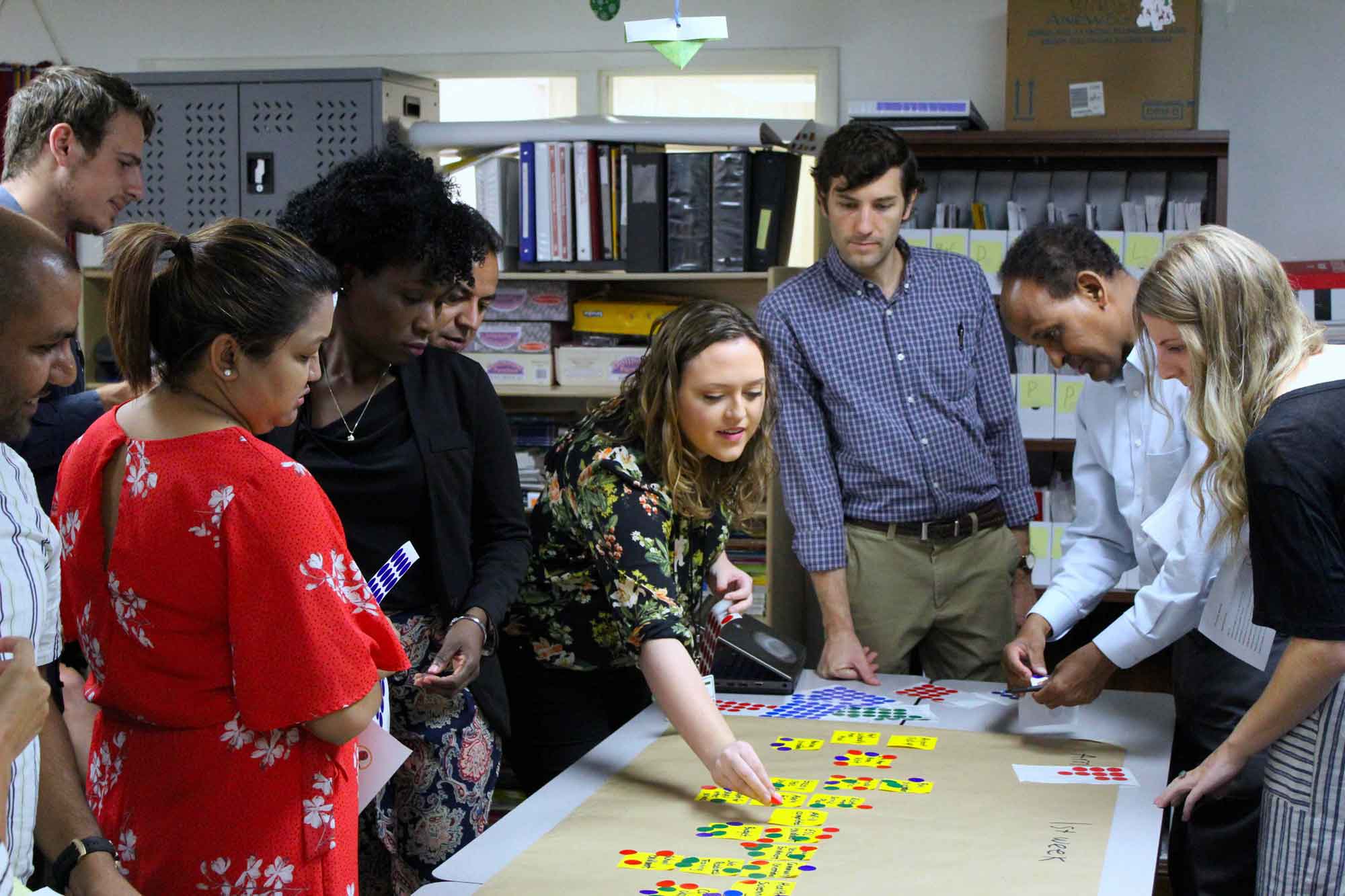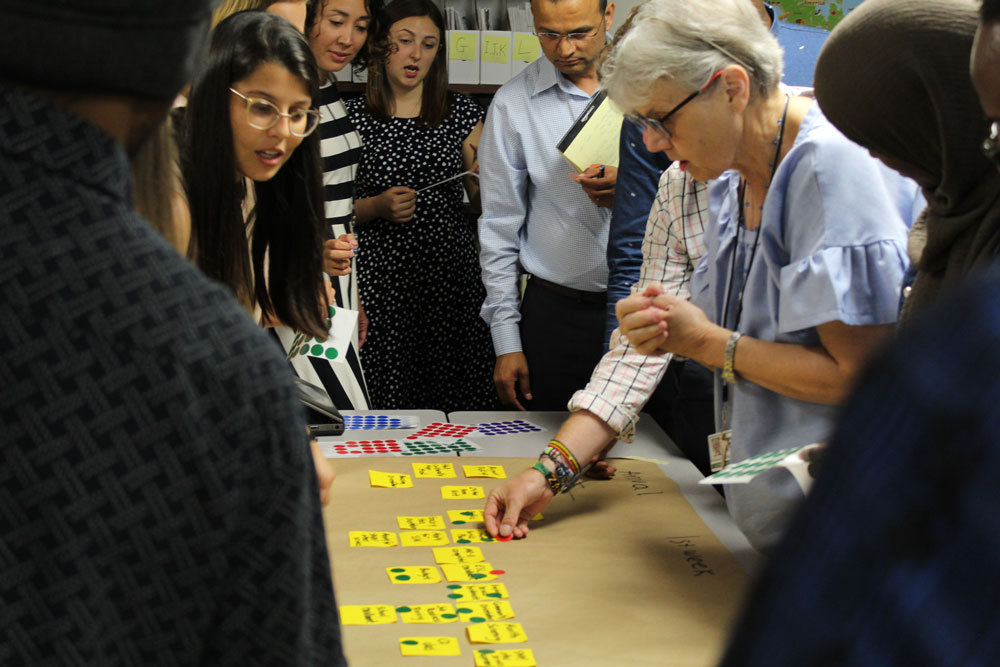
Whole-Office Approach to Cultural Orientation
During the resettlement process, refugees need vital information to prepare for and adjust to life in the United States. They need this information when their attention may be divided as their living circumstances are significantly changing and their mental resources are likely stretched.
While the term “Cultural Orientation” usually refers to a specific class or set of sessions in the refugee resettlement program, refugees hear key Cultural Orientation messages at all stages of the resettlement journey. As such, it’s important that all resettlement staff contribute to reinforcing key Cultural Orientation messages and provide the same accurate information to limit the spread of misinformation.
When all resettlement staff work together to ensure key Cultural Orientation messages are delivered to refugees, we call that the Whole-Office Approach. If you are new to refugee resettlement, please see this resource collection for resources on understanding refugee populations, case management, inclusion, and more.
How can CORE help?
COREs resources make it easier to harmonize Cultural Orientation messaging to refugees throughout the resettlement journey. This toolkit will help you learn more about the resources available to you and offers ways to engage all resettlement staff, from caseworkers and health and employment specialists to those responsible for delivering Cultural Orientation, in the delivery of consistent messaging on Cultural Orientation topics.
Updating how your office integrates Cultural Orientation throughout a refugee’s resettlement journey may feel overwhelming, so we divided these tasks into different steps based on your capacity, time, and budget. Your office can choose to tackle one or all of the following, based on your needs. This toolkit will help your office:
- Increase refugee engagement on key Cultural Orientation topics during the resettlement process in between face-to-face appointments at Resettlement Support Centers and Resettlement Agencies
- Harmonize resettlement and Cultural Orientation messaging so that refugees receive the same information
- Increase the quality, quantity, and methods for delivering resettlement and Cultural Orientation information to refugees

Resettlement staff at the Refugee and Immigrant Services of Archdiocese of Indianapolis participate in the Telephone Icebreaker Activity. 
Resettlement staff at the Community Refugee and Immigration Services office in Columbus, Ohio take part in a Cultural Orientation Mapping Activity. 
Resettlement staff at the Refugee and Immigrant Services of Archdiocese of Indianapolis practice role playing using CORE resources.
Resources for Refugees
CORE’s digital platforms offer more than 500 resources in multiple formats and languages. These platforms and resources prioritize visual simplicity and design clarity, low-literacy and low digital literacy needs, and cultural and linguistic adaptability. If you’re new to CORE, below is an overview of our resources for refugees. Examples of activities you can use during Cultural Orientation using the below resources include: Working with Your Resettlement Agency Using Settle In website Video, Healthcare in the U.S. Using Settle In Resources, Education for Children Using Settle In, and Planning for Expenses Using Settle In.

Settle In Website

Settle In App

Settle In Facebook
Waiting Room Resources
Get Started
Introduce the Whole-Office Approach to Your Office
It can be challenging to get your organization to modify how they deliver Cultural Orientation messages outside of traditional cultural orientation sessions. The following section includes tips on introducing a Whole-Office Approach to your organization and some suggested activities that will foster discussion on how to improve the delivery of Cultural Orientation messaging to refugees you serve.
IMAGE CAROUSEL
Get office leadership on board
Slide Content
Get office leadership on board
Organizational leadership should be included from the planning stage to ensure that this work aligns with organizational strategy and policies, and that the overall implementation is appropriate. The organization’s Cultural Orientation provider will be instrumental in coordinating with organizational leadership to ensure that all parties are well-prepared and in agreement before implementation. It’s important to highlight how this work will improve the resettlement experience for refugees and ensure consistent messaging.
The following slides provide some tasks that leadership can support to help you move forward with this process.
Require all resettlement staff to take CORE’s Online Courses
We recommend all staff take the following online courses through the learning platform: The Refugee Resettlement Journey, Cultural Orientation Defined, and Working Effectively with Interpreters. If you are not registered on CORE’s learning platform, sign up for an account. Once on the page, click Signup in the top right-hand corner. New registrants will receive an email immediately to finalize their account.
Ask all staff to visit the Settle In U.S. website
Ask all staff to visit the Settle In U.S. website to learn what’s available and download the Settle In mobile app onto their phones. Make sure staff review the sections of those platforms that cover the topics they address in their work.
Improve your waiting room and other gathering spaces
The benefits of information repetition make your office waiting room and other gathering spaces a great place to reach refugees between face-to-face appointments. CORE created a number of resources that can help you make your waiting room and other gathering spaces useful for information dissemination and reinforcement. The resources create understanding about the resettlement process and build knowledge that will prepare refugees for arrival and integration.
Across all topics, formats, and languages, there are more than 500 resources in multiple formats and languages available on the Settle In U.S. website that can be used in your office. Learn more on the Waiting Room Resources page.
Identify other touch points for refugees through the resettlement process
If you don’t have a waiting room, think about other opportunities where refugees could interact with Cultural Orientation resources:
- Bring fact sheets or mobile devices on circuit rides, to airport reception, appointments, and home visits.
- Play podcasts during car rides to appointments
- Distribute fact sheets, posters, and palm cards to other community centers and housing areas refugees frequent
- Decorate classrooms, conference rooms, or computer labs with CORE posters
- Include fact sheets and palm cards in welcome packets
Finally, introduce the Whole-Office Approach to your office’s staff in team meetings
To help staff understand their role in Cultural Orientation messaging, the activities below introduce the topic and will lead to a team-wide discussion of how your office can better work together. The following activities could be done at once in a half-day workshop or spread out over several meetings virtually or in person.
Team Building Activities
To help staff understand their role in Cultural Orientation messaging, the following activities introduce the topic and will lead to a team-wide discussion of how your office can better work together. The following activities could be done at once in a half-day workshop or spread out over several meetings virtually or in person.
Telephone Icebreaker
This activity is ideal for discussing how refugees receive information during resettlement and enforces the importance of consistent Cultural Orientation messaging in your office. This activity is best done in person. If your office is still working remotely, the paper folding activity below has a similar objective.
- Before the activity starts, print and cut the Telephone Phrases Document. Fold pieces and put them together in a pile (or bowl or hat if available).
- At the beginning of the activity, split participants into groups of five or more. Ask the participant to stand in a line or circle. If you are working with a small group, you do not need to make multiple lines or circles.
- Ask one participant from the group to select a piece of paper from the pile.
- That participant will read the phrase quietly to the person next to them so that the others in the line cannot hear. The phrase should only be read once. The person listening to the phrase will then repeat what they’ve heard to the next person in the line or circle. Participants will continue to relay the message down the line or circle.
- A variation; during one of the phrases, select a few people and provide them with secret instructions to change one or two aspects of the phrase.
- Conduct debrief:
- What happened during the game?
- How is this similar or different to the experience of resettling to the United States?
- What does this highlight about your roles as a team?
- Use the debrief to highlight the challenge of providing harmonized and consistent messaging to refugees during the resettlement process, while also identifying the value of addressing inconsistent messaging as a team, or whole office.
- It is not necessary to use all the phrases provided in the Telephone Phrase Worksheet.
Used during Refugee Communications Pilot workshops with local resettlement affiliates.
Paper Folding Activity
This exercise encourages participants to consider how one experience may lead to multiple interpretations. This activity will help foster a discussion about how refugees receive and interpret information during resettlement. This activity can be done in person or remotely.
- Each participant should have one piece of blank white paper. Ask participants to close their eyes during the exercise. Inform participants they can not ask any questions during the exercise. If they ask a question about what they should do, tell them to follow the steps as they understand them.
- Instruct participants to do the following:
- Fold the paper in half
- Fold the paper in half again
- Tear off the bottom right corner
- Turn the paper upside down
- Tear off the other bottom right corner
- Ask participants to open their eyes and share their piece of paper so others can see.
- Conduct debrief:
- What did you notice?
- How did you feel when you saw what your paper looked like in comparison to everyone else’s papers? Did anyone think they had done the exercise incorrectly when they saw others’ papers?
- How could there be so many interpretations when I gave everyone the same instructions? Was there one right way to do this exercise?
- How is this similar or different to resettling refugees? What does this highlight about your roles as a team?
- One piece of paper for each participant
Adapted from United States Institute of Peace (USIP) Conflict Resolution Training
Cultural Orientation Mapping Activity
This activity is ideal for helping all resettlement staff see their role in providing Cultural Orientation messaging to refugees. The activity can help foster more teamwork among staff when they see how their roles work together. View modification and tips for instructions on conducting activity virtually.
- Before starting the activity, create a Resettlement Journey Map, by mapping out all the key resettlement activities as a timeline on butcher paper or a large white board. Ideally, this timeline will reflect the order in which activities typically happen for the clients you serve. For help, refer to the Resettlement Activities List provided.
- Ask participants: Are you familiar with the Cultural Orientation Objectives and Indicators? If they are not, take a moment to review them.
- Next provide participants with the Honorine Scenario Document. Divide the participants into four groups, and assign each group with a set of Honorine’s questions from the Honorine Scenario Document. Ask participants to mark every place on the Resettlement Journey Map, where Honorine might ask their assigned questions. Each group should have a unique identifier for their questions using specific marker colors, stickers, or post-it notes.
- After they have marked the map, ask participants the following questions:
- What do you observe on the map?
- Reference certain points of the journey and ask participants what happens if a key Cultural Orientation message is not communicated?
- Looking at this map, how do you see Cultural Orientation delivery? When does it happen? Who does it?
- What is the value of this activity and the observations you’ve made?
- What might you do as a result of conducting this activity?
- Butcher paper or large white board with key resettlement activities mapped in a timeline
- Resettlement Activities List
- Cultural Orientation Objectives and Indicators
- Honorine Scenario Document
- To do this activity remotely, you can use the Cultural Orientation Mapping Activity PowerPoint to mimic the map created on the butcher paper above. Participants will use the annotation tool to mark on the screen.
Used during Refugee Communications Pilot workshops with local resettlement affiliates.
Cultural Orientation Message Delivery: Role Plays
This activity is ideally done after either the Telephone or Paper Folding Activity, AND the Cultural Orientation Mapping Activity. This activity allows resettlement staff to practice integrating CORE materials into their everyday work.
- Split participants in small groups and provide each group with one of the role plays from the CORE Role Play PowerPoint. Each role play in the PowerPoint provides participants the opportunity to practice using different CORE resources during R&P touchpoints discussed in the Cultural Orientation Mapping Activity.
- After role plays, conduct debrief:
- What happened?
- Challenges? Successes?
- Concerns? How can we overcome these?
- At the end, ask the group to brainstorm additional ways and areas they could see using CORE’s resources. Using flip-chart and post-its.
- If conducting this activity remotely, share document with participants and split groups into breakout rooms to conduct the role plays.
Engage All Staff in Delivering Key Cultural Orientation Messages
Now that you’ve introduced your office resettlement staff to the Whole-Office Approach, it’s time to get to work changing how your office delivers key Cultural Orientation messages. Below are some tasks your staff can tackle to implement what you discussed in the group activities.
IMAGE CAROUSEL
Review pre-departure and welcome packets
Slide Content
Review pre-departure and welcome packets
This is a great time to look at the materials provided to refugees during pre-departure and post-arrival. Is it still accurate? Does it address the main questions and concerns refugees have? Is it too much information? Is it in a format that is accessible in terms of literacy and language needs? Consider printing and adding Settle In fact sheets and Settle In mobile app palm cards.
Pre-load refugee devices with Cultural Orientation materials
If refugees have smartphones prior to travel, encourage them to download the Settle In mobile app before departing. If you work at a Resettlement Agency that provides smartphones, tablets, or laptops to refugees, ensure they include Cultural Orientation content. Download Settle In to devices and make sure it’s loaded in their language. Bookmark the Settle In website in their language or make it their browser homepage. Ensure all resettlement staff also have Settle In on their phones to use when applicable. Make sure resettlement staff are introducing the materials to refugees during their appointment times to encourage usage outside the office.
Consider all the touchpoints refugees have in your office
What topic does each staff member support? To help you with this exercise, review this example list another RA office created of touchpoints and what resources could improve that interaction. Create your own list of touchpoints to fill in as an office using this touchpoint template.
For example, Employment Specialists could:
- Integrate CORE fact sheets, videos and podcasts into their appointments or in job readiness training
- Complete the Settle In Working in the United States chapter with refugees
- Hang CORE posters in their office space and reference them when appropriate
Enhance Your Cultural Orientation Sessions
Are you more interested in improving the learning experience in your organization’s Cultural Orientation sessions? CORE has a large selection of resources to help you.
Provider Onboarding
Research and Evidence



